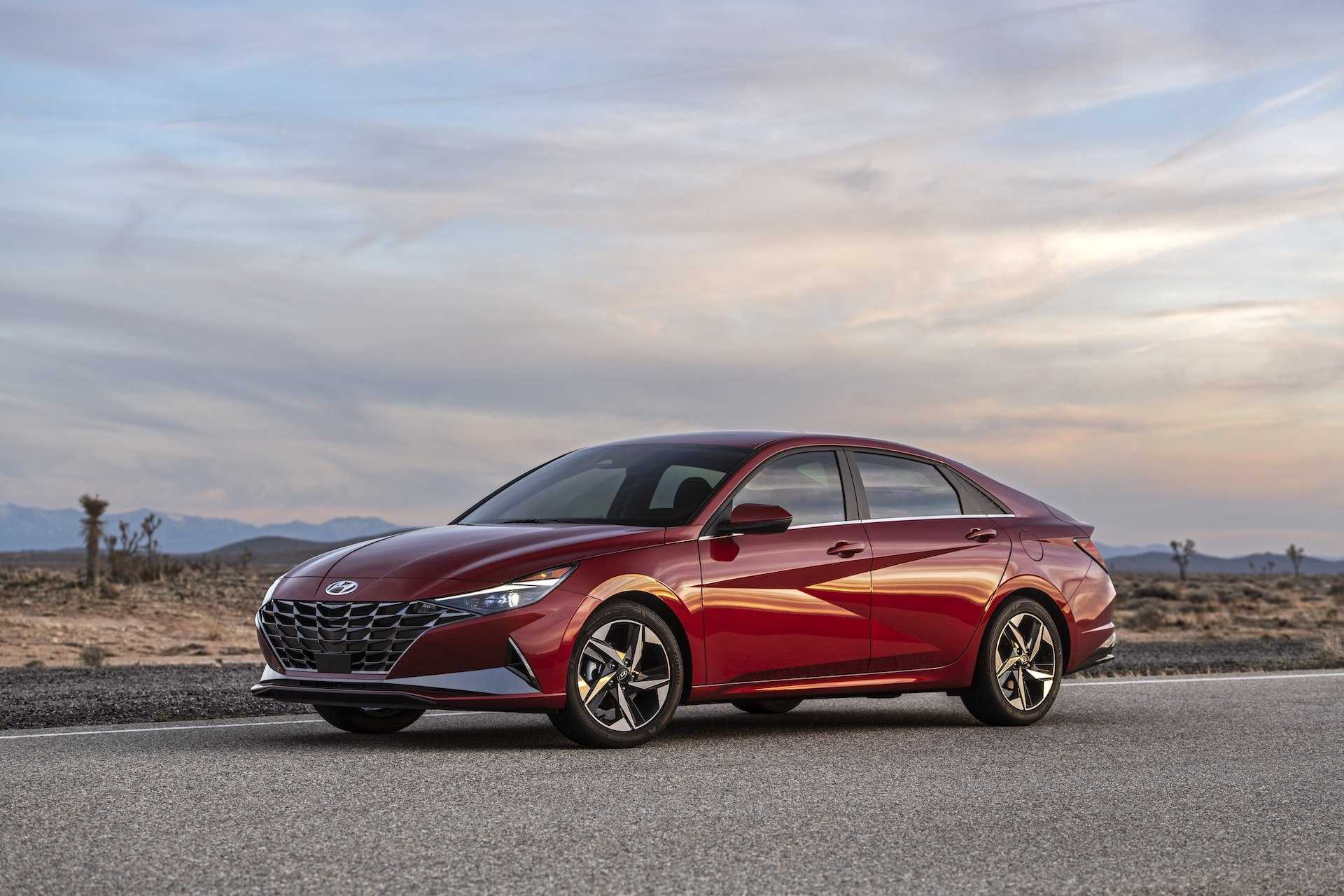 Hyundai Elantra 2023 Dual Clutch, Brake System
Hyundai Elantra 2023 Dual Clutch, Brake System
Welcome to the 2023 Hyundai Elantra Dual Clutch and Brake System, a dynamic combination of performance and accuracy. This in-depth manual is your reliable travel companion as you take off in this cutting-edge sedan, shedding light on the complex dance between the extremely effective brake system and the Dual Clutch Transmission (DCT). A thrilling driving experience is promised by the DCT’s smooth gear changes and efficiency improvements, and every pedal push guarantees your safety and control. Hyundai’s dedication to smooth integration and top performance is evident, ensuring that your experience with the 2023 Elantra is defined by the ideal ratio of power, economy, and road safety.
2023 Hyundai Elantra Specs, Price, Features, Milage (Brochure)
Dual Clutch Transmission
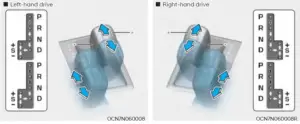
- Depress the brake pedal and press the shift button while moving the shift lever.
- Press the shift button while moving the shift lever.
- The shift lever can freely operate.
Dual Clutch Transmission Operation
The dual-clutch transmission has 7 forward speeds and one reverse speed. The individual speeds are selected automatically in the D (Drive) position.
WARNING
To reduce the risk of serious injury or death:
- ALWAYS check the surrounding areas near your vehicle for people, especially children, before shifting a vehicle into D (Drive) or R (Reverse).
- Before leaving the driver’s seat, always make sure the shift lever
is in the P (Park) position, then set the parking brake, and place the ignition switch in the LOCK/OFF position. Unexpected and sudden vehicle movement can occur if these precautions are not followed. - When using Manual Shift Mode, do not use engine braking (shifting from a high gear to a lower gear) rapidly on slippery roads. The vehicle may slip causing an accident.
- To avoid damage to your transaxle, do not try to accelerate in R (Reverse) or any forward gear position with the brakes on.
- When stopped on the slope, do not hold the vehicle with the accelerator pedal. Use the service brake or the parking brake.
- The dual-clutch transmission can be thought of as an automatically shifting manual transmission. It gives the driving feel of a manual transmission, yet provides the ease of a fully automatic transmission.
- When D (Drive) is selected, the transmission will automatically shift through the gears similar to a conventional automatic transmission. Unlike a traditional automatic transmission, the gear shifting can sometimes be felt and heard as the actuators engage the clutches and the gears are selected.
- The dual-clutch transmission adopts a dry-type dual-clutch, which is different from the torque converter of the automatic transmission. It shows better acceleration performance and increased fuel efficiency while driving but the initial launch might be a little bit slower than the automatic transmission.
As a result, gear shifts are sometimes more noticeable than a conventional automatic transmission and a light vibration during launching can be felt as the transmission speed. This is a normal condition of the dual-clutch transmission. - The dry-type clutch transfers torque more directly and provides a direct drive feeling which may feel different from a conventional automatic transmission. This may be more noticeable when launching the vehicle from a stop or when traveling at low, stop-and-go vehicle speeds.
- When rapidly accelerating at a low vehicle speed, the engine rpm may increase highly depending on the vehicle’s driving condition.
- For a smooth launch uphill, press down the accelerator pedal smoothly depending on the current conditions.
- If you release your foot from the accelerator pedal at low vehicle speed, you may feel strong engine braking, which is similar to a manual transmission.
- When driving downhill, you may use Sports Mode or press the paddle shifters (if equipped) to downshift to a lower gear in order to control your speed without using the brake pedal excessively.
- When you turn the engine on and off, you may hear clicking sounds as the system goes through a self-test. This is a normal sound for the dual-clutch transmission.
- During the first 1000 miles (1,500 km), you may feel that the vehicle may not be smooth when accelerating at low speed. During this break-in period, the shift quality and performance of your new vehicle is continuously optimized.
WARNING
Due to transmission failure, you may not continue to drive and the position indicator (D, R) on the cluster will blink. Contact an authorized HYUNDAI dealer and have the system checked.
LCD Display for Transmission Temperature and Warning Message
DCT warning messages
This warning message is displayed when the vehicle is driven slowly on a grade and the vehicle detects that the brake pedal is not applied.
Steep grade
Driving up hills or on steep grades:
- To hold the vehicle on an incline use the foot brake or the parking brake.
- When in stop-and-go traffic on an incline, keep some distance ahead before moving the vehicle forward. Then hold the vehicle on the incline with the foot brake.
- If the vehicle is held on a hill by applying the accelerator pedal or by creeping with the brake pedal disengaged, the clutch and transmission may overheat which can result in damage. At this time, a warning message will appear on the LCD display.
- If the LCD warning is active, the foot brake must be applied.
- Ignoring the warnings can lead to damage to the transmission.
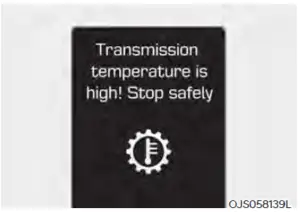
Transmission high temperature
- Under certain conditions, such as repeated stop-and-go launches on steep grades, sudden take-off or acceleration, or other harsh driving conditions, the transmission clutch temperatures will increase excessively. Finally, the clutch in the transmission could be overheated.
- When the clutch is overheated, the safe protection mode engages and the gear position indicator on the cluster blinks with a chime. At this time, the “Transmission temperature is high! Stop safely” warning message will appear on the LCD display and driving may not be smooth.
- If this occurs, pull over to a safe location, stop the vehicle with the engine running, apply the brakes shift the vehicle to P (Park), and allow the transmission to cool.
- If you ignore this warning, the driving condition may become worse.
You may experience abrupt shifts, frequent shifts, or jerkiness. To return to normal driving conditions, stop the vehicle and apply the foot brake or shift into P (Park). Then allow the transmission to cool for a few minutes with the engine on, before driving off. - When possible, drive the vehicle smoothly.

Transmission overheated
- If the vehicle continues to be driven and the clutch temperatures reach the maximum temperature limit, the “Transmission hot! Park with engine On” warning will be displayed. When this occurs the clutch is disabled until the clutch cools to normal temperatures.
- The warning will display a time to wait for the transmission to cool.
- If this occurs, pull over to a safe location, stop the vehicle with the engine running, apply the brakes shift the vehicle to P (Park), and allow the transmission to cool.
- When the message “Transmission cooled down. Resume driving” appears you can continue to drive your vehicle.
- When possible, drive the vehicle smoothly.
If any of the warning messages in the LCD display continue to blink, for your safety, contact an authorized HYUNDAI dealer and have the system checked.
Transmission ranges
The indicator in the instrument cluster displays the shift lever position when the ignition switch is in the ON position.
P (Park)
Always come to a complete stop before shifting into P (Park).
To shift from P (Park), you must depress firmly on the brake pedal and make sure your foot is off the accelerator pedal.
If you have done all of the above and still cannot shift the lever out of P (Park), see “Shift-Lock Release” in this chapter.
The shift lever must be in P (Park) before turning the engine off.
WARNING
- Shifting into P (Park) while the vehicle is in motion may cause you to lose control of the vehicle.
- After the vehicle has stopped, always make sure the shift lever is in P (Park), apply the parking brake, and turn the engine off.
- Do not use the P (Park) position in place of the parking brake.
R (Reverse)
Use this position to drive the vehicle backward.
NOTICE
Always come to a complete stop before shifting into or out of R (Reverse); you may damage the transaxle if you shift into R (Reverse) while the vehicle is in motion.
N (Neutral)
The wheels and transaxle are not engaged.
Use N (Neutral) if you need to restart a stalled engine, or if it is necessary to stop with the engine ON. Shift into P (Park) if you need to leave your vehicle for any reason.
Always depress the brake pedal when you are shifting from N (Neutral) to another gear.
D (Drive)
This is the normal driving position. The transmission will automatically shift through a 7-gear sequence, providing the best fuel economy and power.
For extra power when passing another vehicle or driving uphill, depress the accelerator fully. The transmission will automatically downshift to the next lower gear (or gears, as appropriate).
The DRIVE MODE switch, located on the shift lever console, allows the driver to switch from NORMAL mode to ECO or SPORT mode (if equipped)
For more information, refer to “Drive Mode Integrated Control System” later in this chapter.
WARNING
- Do not shift into gear unless your foot is firmly on the brake pedal. Shifting into gear when the engine is running at high speed can cause the vehicle to move very rapidly. You
may lose control of the vehicle and cause accidents. - Do not drive with the shift lever in N (Neutral). The engine brake will not work and may lead to an accident.
NOTICE
Always make sure the vehicle is stationary, at a complete stop, before selecting D (Drive).
Shift-lock system
For your safety, the dual-clutch transmission has a shift-lock system that prevents shifting the transmission from P (Park) into R (Reverse) unless the brake pedal is depressed.
To shift the transmission from P (Park) into R (Reverse):
- Depress and hold the brake pedal.
- Start the engine or place the ignition switch in the ON position.
- Move the shift lever.
Shift-lock release
If the shift lever cannot be moved from the P (Park) position into R (Reverse) position with the brake pedal depressed, continue depressing the brake, and then do the following:
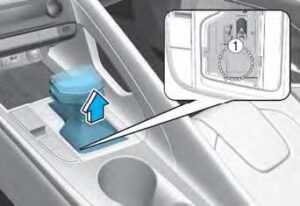
- Place the ignition switch in the LOCK/OFF position
- Apply the parking brake.
- Carefully remove the shift lever boots.
- Move the shift lever while holding the release button (1) with a tool (for example, a flathead screwdriver).
If you need to use the shift-lock release, have the vehicle inspected by an authorized HYUNDAI dealer immediately.
CAUTION
Be careful not to damage the trim beside the shift lever while removing the shift lever boots.
Ignition key interlock system (if equipped)
The ignition key cannot be removed unless the shift lever is in the P (Park) position.
Parking
Always come to a complete stop and continue to depress the brake pedal. Move the shift lever into the P (Park) position, apply the parking brake, and place the ignition switch in the LOCK/OFF position. Take the Key with you when exiting the vehicle.
WARNING
When you stay in the vehicle with the engine running, be careful not to depress the accelerator pedal for a long period of time. The engine or exhaust system may overheat and start a fire. The exhaust gas and the exhaust system are very hot. Keep away from the exhaust system components. Do not stop or park over flammable materials, such as dry grass, paper, or leaves. They may ignite and cause a fire.
Good Driving Practices
- Never move the shift lever from P (Park) or N (Neutral) to any other position with the accelerator pedal depressed.
- Never move the shift lever into P (Park) when the vehicle is in motion.
Be sure the vehicle is completely stopped before you attempt to shift into R (Reverse) or D (Drive). - Do not move the shift lever to N (Neutral) when driving. Doing so may result in an accident because of a loss of engine braking and the transmission could be damaged.
- When driving uphill or downhill, always shift to D (Drive) for driving forward or shift to R (Reverse) for driving rearwards. After selecting
D (Drive) or R (Reverse), check the gear position indicated on the cluster before driving. If the vehicle moves in the opposite direction of the selected gear, the engine may turn off and a serious accident might occur due to degraded brake performance. - Do not drive with your foot resting on the brake pedal. Even light, but consistent pedal pressure can result in the brakes overheating, brake wear, and possibly even brake failure.
- When driving in sports mode, slow down before shifting to a lower gear. Otherwise, the lower gear may not be engaged if the engine RPMs are outside of the allowable range.
- Always apply the parking brake when leaving the vehicle. Do not depend on placing the transmission in P (Park) to keep the vehicle from moving.
- Exercise extreme caution when driving on a slippery surface. Be especially careful when braking, accelerating, or shifting gears. On a slippery surface, an abrupt change in vehicle speed can cause the drive wheels to lose traction and may cause loss of vehicle control resulting in an accident.
- Optimum vehicle performance and economy is obtained by smoothly depressing and releasing the accelerator.
WARNING
- To reduce the risk of SERIOUS INJURY or DEATH:
- ALWAYS wear your seatbelt. In a\ collision, an unbelted occupant is significantly more likely to be seriously injured or killed than a properly belted occupant.
- Avoid high speeds when cornering or turning.
- Do not make quick steering wheel movements, such as sharp lane changes or fast, sharp turns.
- The risk of rollover is greatly increased if you lose control of your vehicle at highway speeds.
- Loss of control often occurs if two or more wheels drop off the roadway and the driver oversteers to reenter the roadway.
- In the event your vehicle leaves the roadway, do not steer sharply. Instead, slow down before pulling back into the travel lanes.
- HYUNDAI recommends you follow all posted speed limits
WARNING
If your vehicle is stuck in snow, mud, sand, etc., you may attempt to free the vehicle by rocking it back and forth. Do not attempt this procedure if people or objects are anywhere near. A vehicle may suddenly move forward or backward as it becomes unstuck, causing injury or damage to nearby people or objects.
BRAKE SYSTEM
Power Brakes
Your vehicle has power-assisted brakes that adjust automatically through normal usage. If the engine is not running or is turned off while driving, the power assist for the brakes will not work. You can still stop your vehicle by applying greater force to the brake pedal than typical. The stopping distance, however, will be longer than with power brakes.
When the engine is not running, the reserve brake power is partially depleted each time the brake pedal is applied. Do not pump the brake pedal when the power assist has been interrupted.
Only pump the brakes on slippery surfaces if the power assist has been interrupted to maintain steering control. Do not pump the brakes on slippery surfaces if the brakes are operating normally.
Information
- When the brake pedal is depressed under certain
driving conditions or weather conditions, you may temporarily hear a noise. This is normal and does not indicate a problem with your brakes. - While driving on a road with deicing chemicals, brake noise or abnormal tire wear may occur due to deicing chemicals. In safe traffic conditions, apply the brakes to remove deicing chemicals on the brake discs and pads.
WARNING
Take the following precautions:
- Do not drive with your foot resting on the brake pedal. This will create abnormally high brake temperatures, excessive brake lining and pad wear, and increased stopping distances.
- When descending down a long or steep hill, move the gear shift button to Manual Shift Mode and manually downshift to a lower gear in order to control your speed without using the brake pedal excessively. Applying the brakes continuously will cause the brakes to overheat and could result in a temporary loss of braking performance.
- Wet brakes may impair the vehicle’s ability to safely slow down; the vehicle may also pull to one side when the brakes are applied. Applying the brakes lightly will indicate whether they have been affected in this way. Always test your brakes in this fashion after driving through deep water. To dry the brakes, lightly tap the brake pedal to heat up the brakes while maintaining a safe forward speed until brake performance returns to normal. Avoid driving at high speeds until the brakes function correctly.
Disc Brakes Wear Indicator
When your brake pads are worn and new pads are required, you will hear a high-pitched warning sound from your front or rear brakes. You may hear this sound come and go or it may occur whenever you depress the brake pedal.
NOTICE
To avoid costly brake repairs, do not continue to drive with worn brake pads.
Information
Always replace brake pads as complete front or rear axle sets.
Parking Brake (if equipped) Applying the parking brake
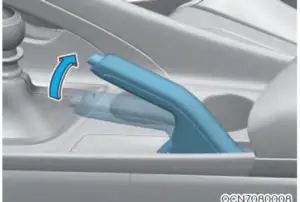
Always set the parking brake before leaving the vehicle, to apply:
Firmly depress the brake pedal. Pull up the parking brake lever as far as possible.
WARNING
To reduce the risk of SERIOUS INJURY or DEATH, do not operate the parking brake while the vehicle is moving except in an emergency situation. It could damage the brake system and lead to an accident.
Releasing the parking brake
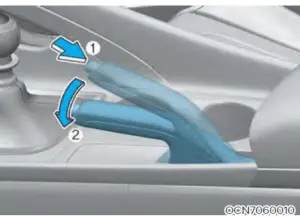
To release:
Firmly depress the brake pedal. While pressing the release button (1), slightly pull up on the parking brake lever then lower the parking brake lever (2).
WARNING
- Whenever leaving the vehicle or parking, always come to a complete stop and continue to depress the brake pedal. Move the shift lever into the 1st gear (for manual transmission vehicle) or P (Park, for intelligent variable transmission vehicle) position, then apply the parking brake and place the ignition switch in the LOCK/OFF position.
- Vehicles with the parking brake not fully engaged are at risk of moving inadvertently and causing injury to yourself or others.
- NEVER allow anyone who is unfamiliar with the vehicle to touch the parking brake. If the parking brake is released unintentionally, serious injury may occur.
- Only release the parking brake when you are seated inside the vehicle with your foot firmly on the brake pedal.
WARNING
- Whenever leaving the vehicle or parking, always come to a complete stop and continue to depress the brake pedal. Move the shift lever into the 1st gear (for manual transmission
vehicle) or P (Park, for intelligent variable transmission vehicle) position, then apply the parking brake and place the ignition switch in the LOCK/OFF position. - Vehicles with the parking brake not fully engaged are at risk of moving inadvertently and causing injury to yourself or others.
- NEVER allow anyone who is unfamiliar with the vehicle to touch the parking brake. If the parking brake is released unintentionally, serious injury may occur.
- Only release the parking brake when you are seated inside the vehicle with your foot firmly on the brake pedal.
NOTICE
- Do not apply the accelerator pedal while the parking brake is engaged. If you depress the accelerator pedal with the parking brake engaged, a warning will sound. Damage to the parking brake may occur.
- Driving with the parking brake on can overheat the braking system and cause premature wear or damage to brake parts. Make sure the parking brake is released and the Brake Warning Light is off before driving.
Check the Parking Brake Warning Light by placing the ignition switch to the ON position (do not start the engine). This light will be illuminated when the parking brake is applied with the ignition switch in the START or ON position. Before driving, be sure the parking brake is released and the Brake Warning Light is OFF.
If the Parking Brake Warning Light remains on after the parking brake is released while the engine is running, there may be a malfunction in the brake system. Immediate attention is necessary. If at all possible, cease driving the vehicle immediately. If that is not possible, use extreme caution while operating the vehicle and only continue to drive the vehicle until you can reach a safe location.
2023 Hyundai Elantra Specs, Price, Features, Milage (Brochure)
Electronic Parking Brake (EPB) (if equipped)
Applying the parking brake
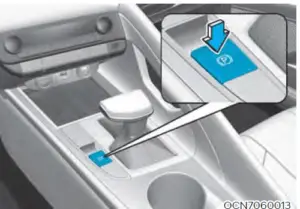
To apply the EPB (Electronic Parking Brake):
- Depress the brake pedal.
- Pull up the EPB switch.
Make sure the parking brake warning light comes on.
WARNING
To reduce the risk of SERIOUS INJURY or DEATH, do not operate the EPB while the vehicle is moving except in an emergency situation. It could damage the brake system and lead to an accident.
Releasing the parking brake
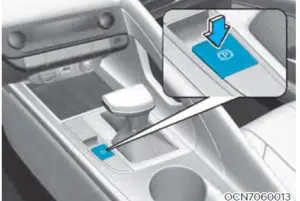
To release the EPB (Electronic Parking Brake), press the EPB switch in the following condition:
- Place the ignition switch in the ON position.
- Depress the brake pedal.
Make sure the Parking Brake Warning Light goes off.
To release EPB (Electronic Parking Brake) automatically:
- Intelligent variable transmission
- Start the engine.
- Close the driver’s door, engine hood, and trunk.
- Depress the accelerator pedal while the shift lever is in R (Reverse) or D (Drive).
Make sure the Parking Brake Warning light goes off.
Information
- For your safety, you can engage the EPB even though the ignition switch is in the OFF position, but you cannot release it.
- For your safety, depress the brake pedal and release the parking brake manually with the EPB switch when you drive downhill or when backing up the vehicle.
NOTICE
- If the parking brake warning light is still on even though the EPB has been released, have the system checked by an authorized HYUNDAI dealer.
- Do not drive your vehicle with the EPB applied. It may cause excessive brake pad and brake rotor wear. EPB (Electronic Parking Brake) may be automatically applied when:
- Requested by other systems
- The driver turns the engine off while MAuto Hold is operating.
- The vehicle is parked on the slope and the Engine Start/Stop button is in the OFF position.
- The Engine is turned off when the driver tries to park but the vehicle still moves a bit
Warning messages
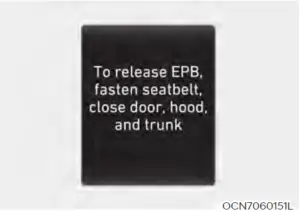
To release EPB, fasten the seatbelt, close the door, hood, and trunk
- If you try to drive with the EPB applied, a warning will sound and a message will appear.
- If the driver’s seat belt is unfastened and the engine hood or trunk is opened, a warning will sound and a message will appear.
- If there is a problem with the vehicle, a warning may sound and a message may appear.
If the situation occurs, depress the brake pedal and release EPB by pressing the EPB switch.
WARNING
- Whenever leaving the vehicle or parking, always come to a complete stop and continue to depress the brake pedal.
Shift the gear into the P (Park) position, press the EPB switch, and set the ignition switch to the OFF position. Take the Key with you when exiting the vehicle.
Vehicles not fully engaged in P (Park) with the parking brake set are at risk of moving inadvertently and causing injury to yourself or others. - NEVER allow anyone who is unfamiliar with the vehicle to touch the EPB switch. If the EPB is released unintentionally, serious injury may occur.
- Only release the EPB when you are seated inside the vehicle with your foot firmly on the brake pedal.
NOTICE
- Do not apply the accelerator pedal while the parking brake is engaged. If you depress the accelerator pedal with the EPB engaged, a warning will sound and a message will appear. Damage to the parking brake may occur.
- Driving with the parking brake on can overheat the braking system and cause premature wear or damage to brake parts. Make sure the EPB is released and the Parking Brake Warning Light is off before driving.
Information
- A clicking sound may be heard while operating or releasing the EPB. These conditions are normal and indicate that the EPB is functioning properly.
- When leaving your keys with a parking attendant or assistant, make sure to inform him/her how to operate the EPB.
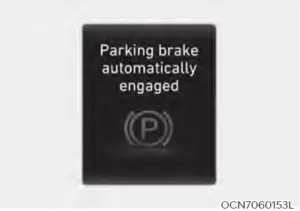
AUTO HOLD turning Off!
Press brake pedal
When the conversion from Auto Hold to EPB is not working properly a warning will sound and a message will appear.
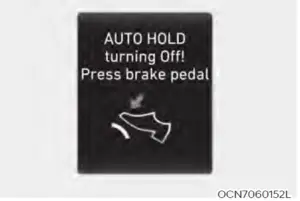
Parking brake automatically engaged
If the EPB is applied while Auto Hold is activated, a warning will sound and a message will appear
EPB malfunction indicator

This warning light illuminates if the ignition switch is set to the ON position and goes off in approximately 3 seconds if the system is operating normally.
If the EPB malfunction indicator remains on, comes on while driving, or does not come on when the ignition switch is changed to the ON position, this indicates that the EPB may have malfunctioned.
If this occurs, have the system checked by an authorized HYUNDAI dealer.
The EPB malfunction indicator may illuminate when the ESC indicator comes on to indicate that the ESC is not working properly, but it does not indicate a malfunction of the EPB.
NOTICE
- If the EPB warning light is still on, have the system checked by an authorized HYUNDAI dealer.
- If the parking brake warning light does not illuminate or blinks even though the EPB switch was pulled up, the EPB may not be applied.
- If the parking brake warning light blinks when the EPB warning light is on, press the switch, and then pull it up. Repeat this one more time. If the EPB warning does not go off, have the system checked by an authorized HYUNDAI dealer
Emergency braking
If there is a problem with the brake pedal while driving, emergency braking is possible by pulling up and holding the EPB switch. Braking is possible only while you are holding the EPB switch. However, braking distance will be longer than normal.
WARNING
Do not operate the parking brake while the vehicle is moving except in an emergency situation. It could damage the brake system and lead to a severe accident.
Information
During emergency braking, the parking brake warning light will illuminate to indicate that the system is operating.
NOTICE
If you continuously notice a noise or burning smell when the EPB is used for emergency braking, have the system checked by an authorized HYUNDAI dealer.
When the EPB (Electronic Parking Brake) does not release
If the EPB does not release normally, contact an authorized HYUNDAI dealer by loading the vehicle on a flatbed tow truck and have the system checked.
Auto Hold
The Auto Hold maintains the vehicle at a standstill even though the brake pedal is not depressed after the driver brings the vehicle to a complete stop by depressing the brake pedal.
Information
The Auto Hold On or Off setting is maintained when the vehicle is turned off. When the vehicle is restarted the last setting for Auto Hold is applied.
To apply :
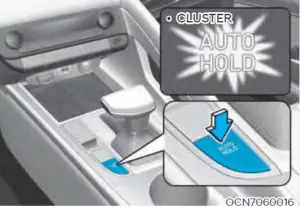
- With the driver’s door and engine hood closed, depress the brake pedal and then press the [AUTO HOLD] switch. The white AUTO HOLD indicator will come on and the system will be in the standby position.
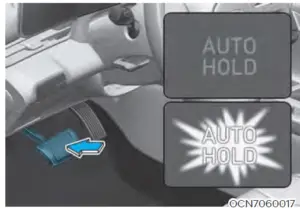
- When you stop the vehicle completely by depressing the brake pedal, the Auto Hold maintains the brake pressure to hold the vehicle stationary. The indicator changes from white to green.
- The vehicle will remain stationary even if you release the brake pedal.
- If EPB is applied, Auto Hold will be released.
- To release :
If you press the accelerator pedal with the gear in D (Drive), R (Reverse) or Manual shift mode, the Auto Hold will be released automatically and the vehicle will start to move. The AUTO HOLD indicator changes from green to white.
WARNING
When the AUTO HOLD is automatically released by depressing the accelerator pedal, always take a look around your vehicle.
Slowly depress the accelerator pedal for a smooth start.
To cancel :
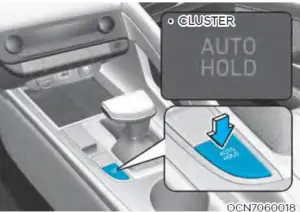
- Depress the brake pedal.
- Press the [AUTO HOLD] switch. The AUTO HOLD indicator will turn off.
WARNING
To prevent, unexpected and sudden vehicle movement, ALWAYS press your foot on the brake pedal to cancel the
Auto Hold before you:
- Drive downhill.
- Drive the vehicle in R (Reverse).
Park the vehicle.
Information
- The Auto Hold does not operate when:
- The driver’s door is opened
- The engine hood is opened in D (Driving) or N (Neutral)
- The shift lever is in P (Park)
- The trunk is opened in R (Reverse)
- The EPB is applied
- The vehicle stops more than 30 minutes.
- For your safety, the Auto Hold automatically switches to EPB when:
- The driver’s door is opened in D (Driving) or N(Neutral).
- The engine hood is opened.
- The trunk is opened in R (Reverse).
- The vehicle stops for more than 10 minutes
- The vehicle stands on a steep slope
- The vehicle moves several times
- The vehicle stops for more than 30 minutes accumulatively.
the warning light comes on, the AUTO HOLD indicator changes from green to white, and a warning sound and a message will appear to inform you that EPB has been automatically engaged.
Before driving off again, press the foot brake pedal, check the surrounding area near your vehicle, and release the parking brake manually with the EPB switch.
- While operating Auto Hold, you may hear mechanical noise. However, it is normal operating noise
NOTICE
If the AUTO HOLD indicator changes to yellow, the Auto Hold is not working properly. Contact an authorized HYUNDAI dealer.
WARNING
- Depress the accelerator pedal slowly when you start the vehicle.
- For your safety, cancel the Auto Hold when you drive downhill, back up the vehicle, or park the vehicle.
NOTICE
If there is a malfunction with the driver’s door or engine hood open detection system, the Auto Hold may not work properly.
Contact an authorized HYUNDAI dealer.
Warning messages

The parking brake automatically engaged
When the EPB is applied from Auto Hold, a warning will sound and a message will appear.

AUTO HOLD turning Off!
Press brake pedal
When the conversion from Auto Hold to EPB is not working properly a warning will sound and a message will appear.
When this message is displayed, the Auto Hold and EPB may not operate. For your safety, depress the brake pedal.
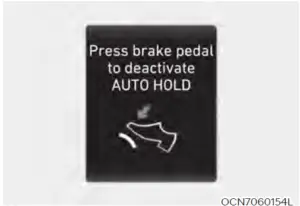
Press the brake pedal to deactivate the AUTO HOLD
If you did not apply the brake pedal when you release the Auto Hold by pressing the [AUTO HOLD] switch, a warning will sound and a message will appear.
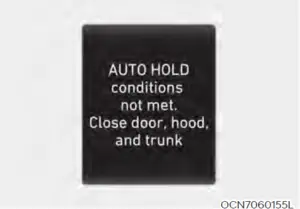
AUTO HOLD conditions not met. Close the door, hood, and trunk
When you press the [AUTO HOLD] switch, if the driver’s door and engine hood are not closed, a warning will sound and a message will appear on the cluster LCD display.
Press the [AUTO HOLD] switch after closing the driver’s door and hood.
FAQ
The Dual Clutch Transmission is an advanced automatic transmission system that combines the efficiency of a manual transmission with the convenience of an automatic.
The DCT utilizes two separate clutches to enable quick and smooth gear shifts, providing improved fuel efficiency and performance compared to traditional automatic transmissions.
Some Elantra models equipped with DCT may offer manual shifting modes, allowing you to manually select gears when desired.
The User Guide should outline recommended maintenance for the DCT, such as fluid changes and inspections.
The DCT is designed to adapt to various driving conditions automatically, but the User Guide may provide guidance on how to optimize performance for specific situations.
The Elantra typically features a hydraulic brake system with disc brakes on all wheels.
The User Guide should offer information on brake maintenance, including brake pad replacement, brake fluid checks, and rotor inspections.
Some models may offer safety features like anti-lock brakes (ABS), electronic brake-force distribution (EBD), and brake assist. The User Guide may provide details.
The User Guide may include troubleshooting tips for addressing brake pedal vibrations or noise and when to seek service.
The User Guide should provide instructions on how to engage and disengage the parking brake or emergency brake.
Some vehicles have a brake override system that prioritizes braking over acceleration when both pedals are pressed simultaneously. The User Guide may explain this feature.
The User Guide may provide guidance on what actions to take if the brake warning light on the instrument cluster comes on.
The User Guide may explain how the DCT and brake system work together to provide smooth and efficient driving.
The User Guide may provide information on how the DCT and brake system contribute to safety features like hill-start assist and electronic stability control.
If your Elantra allows manual gear changes with the DCT, the User Guide should explain how to coordinate braking while shifting gears manually.
Useful Link
View Full User Guide: Hyundai Elantra 2023 User Guide
Download Manuals: https://owners.hyundaiusa.com/us/en/resources/manuals-warranties.html
2023 Hyundai Elantra Specs, Price, Features, Milage (Brochure)

